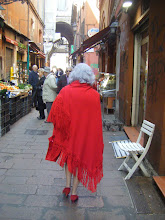 I have been on a huge Virginia Woolf kick for the last couple months. The craze was ignited by one of the many discussions on books my friend Emily and I used to have at our respective offices. She couldn't believe that I hadn't read any of Woolf's major novels, so I decided to remedy that, not knowing that Woolf would turn out to be one of my favorite writers. I began with "To the Lighthouse" and hated it. I persevered, though, and continued on to "The Waves," "A Room of One's Own," "Mrs. Dalloway," "Between the Acts," and most recently "Orlando," which just might be one of my favorites.
I have been on a huge Virginia Woolf kick for the last couple months. The craze was ignited by one of the many discussions on books my friend Emily and I used to have at our respective offices. She couldn't believe that I hadn't read any of Woolf's major novels, so I decided to remedy that, not knowing that Woolf would turn out to be one of my favorite writers. I began with "To the Lighthouse" and hated it. I persevered, though, and continued on to "The Waves," "A Room of One's Own," "Mrs. Dalloway," "Between the Acts," and most recently "Orlando," which just might be one of my favorites."Orlando," though it was probably not Woolf's intention, was truly a book for fashion lovers of all sorts. Even Karl Lagerfeld cited Orlando as his favorite hero of literature (in the VF Proust Questionnaire, naturally). If you have already read the book, then I am sure you completely understand why a venerated fashion designer might remark that. If not, I'll do my best to elucidate some of the more fashion-y passages in Woolf's most fanciful novel, "Orlando."
Along with being an ode to fashion, "Orlando" transcends time and gender, for young Orlando began his life as a member of the court of Queen Elizabeth I and ended it as a young woman in 1920s England. The young woman he became had a striking resemblance to Oscar Wilde, strangely enough. Take a glimpse at the photos in the Harcourt edition and you may leave with the same response. Anyhow, back to the clothes. Orlando was quite the snazzy dresser as both a male and female. This notion of morphing genders was defined as gynomorphosis, for the individual retained masculine traits but transformed them into the feminine counterpart. So, Orlando fluctuated from petticoats and gossamer to stirrups and overcoats, or vice verse.
Clothes were always central to Orlando's being and even accounted for the changes in his/her mindset, attitude, and behavior:
"The change of clothes had, some philosophers will say, much to do with it. Vain trifles as they may seem, clothes have, they say, more important offices than merely to keep us warm. They change our view of the world and the world's view of us."
Isn't that the truth? Clothes are hardly frivolous and irrelevant, and I was thrilled that Woolf reminded us of that.
Clothes transform us:
"There is much to support the view that it is clothes that wear us and not we them; we may make them take the mould of arm or breast, but they mould our hearts, our brain, our tongues to their liking."
Who has not felt differently inside when dressed one way as opposed to another? I know that I feel most confident when I am dressed up- in skirts, dresses, suits, or other stylishly sophisticated, yet conservative, creations. I can be in a foul mood when I am under dressed- denim and no blazer, flats when I should be in heels, etc. Clothes do more than cover our bodies: they provide confidence. Clothes can change your outlook, redefine you, and improve your morale. Clothing can also define the genders, as in the case of Orlando, or leave it for interpretation, like androgyny. Clothing is so much more than merely something worn out of utility and necessity.
"Orlando" was dedicated to Woolf's lover, Vita Sackville-West, and so it was thought that this book was something of a love letter to her. Perhaps it was also meant to encourage others to look beyond gender stereotypes and characteristics, to see each person as an individual, and to let that be the basis for judgement.
"Orlando" pushed these boundaries, even if the plot was pure time-traveling fantasy.
Virginia Woolf also reminded her readers of the never-ending significance and power of clothing.
Surely that was why Karl Lagerfeld considered Orlando to be the greatest hero of fiction.
** Quotations are from the Harcourt edition of "Orlando" by Virginia Woolf

No comments:
Post a Comment